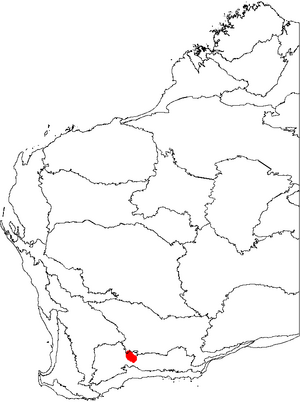Sticky dryandra facts for kids
Banksia viscida, also known as sticky dryandra, is a small shrub. It is only found on four rocky hills in the dry, inland part of Western Australia. For a long time, it was called Dryandra viscida. Scientists believe it is rare, but it is not currently in danger of disappearing.
Quick facts for kids Sticky dryandra |
|
|---|---|
| Scientific classification | |
| Genus: |
Banksia
|
| Species: |
viscida
|
| Synonyms | |
|
Dryandra viscida A.S.George |
|
Contents
What it Looks Like
Banksia viscida grows as a small, bushy plant that forms a round shape. It is usually less than 1 metre (3 ft) tall. Its leaves are long, about 15 to 35 centimetres (5.9 to 14 in) (6 to 14 inches) in length and 5 to 10 millimetres (0.20 to 0.39 in) (0.2 to 0.4 inches) wide. These leaves have many small, triangle-shaped parts along their edges, usually 25 to 75 on each side.
The flowers are golden yellow. They grow in dome-shaped clusters, each with 40 to 55 flowers. These clusters can be up to 4 centimetres (2 in) (1.5 inches) across. After the flowers bloom, the plant may grow several seed pods. Each pod usually holds two seeds, but sometimes only one.
How it Got its Name
Scientists first collected samples of this plant from places like South Ironcap and west of Digger Rocks. The main sample used to describe the plant was collected by a scientist named Alex George in 1969.
In 1996, Alex George officially described the species. He placed it in a group called Dryandra and named it viscida. The word "viscida" comes from a Latin word meaning "sticky." This name refers to the sticky parts around its flowers. So, for a while, its full name was Dryandra viscida A.S.George.
Later, in 2007, two other scientists, Austin Mast and Kevin Thiele, moved all the Dryandra plants into the Banksia group. This means the plant's current name is Banksia viscida.
Where it Lives
Banksia viscida is only found in four specific spots. These are rocky, reddish hills located where the Coolgardie and Mallee natural areas meet. These spots include Digger Rocks, Middle Ironcap, South Ironcap, and Hatter Hill.
The plant grows in rocky soil among thick bushes. This area is very hot and dry. It gets only a little rain each year, about 300 to 350 millimetres (12 to 14 in) (12 to 14 inches). Also, it can have up to 90 days a year where the temperature is hotter than 30 °C (86 °F) (86°F).
How it Survives
Like many other plants in the Proteaceae family, Banksia viscida has special roots called proteoid roots. These roots have many tiny branches that form a thick mat just under the leaves on the ground. These special roots help the plant take in nutrients from poor soil, especially in places where there isn't much phosphorus.
This plant does not have a special underground stem (called a lignotuber) that helps it regrow after a fire. So, bushfires will kill the plant. However, it is adapted to release its seeds after a fire. This means new plants can quickly grow back in the burned area.
The plant is listed as "Priority Three - Poorly Known Taxa" by Western Australia's Department of Environment and Conservation. This means it seems to be rare but not in danger. However, more studies are needed to be sure.
Growing Banksia viscida
Not many people grow Banksia viscida in their gardens. Its seeds sprout well, but the young plants can be hard to get started and grow slowly. It has been grown successfully in clay-like soil in northern Victoria. However, attempts to grow it in the sandy soils of Perth have not worked.
Some experts suggest that because it's a small, compact shrub with nice leaves, it would be good for a small garden. It needs warm, dry weather with lots of sun and heavy, well-drained soil. It can handle dry conditions and frost.


